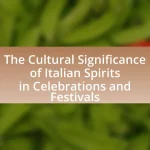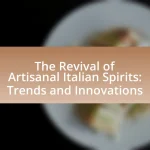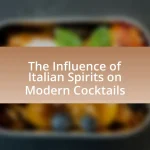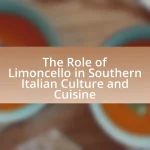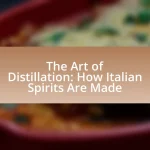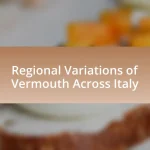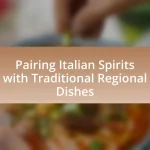Artisanal Italian spirits are handcrafted alcoholic beverages produced in small batches, emphasizing traditional methods and high-quality local ingredients. This article explores the revival of these spirits, including grappa, amaro, and limoncello, highlighting their unique regional characteristics and the cultural heritage they embody. It examines the growing consumer interest in authenticity and sustainability, the impact of local sourcing on flavor profiles, and current trends in the artisanal spirits market. Additionally, the article discusses innovations in production techniques, effective marketing strategies, and resources for consumers to engage with and learn more about these distinctive beverages.
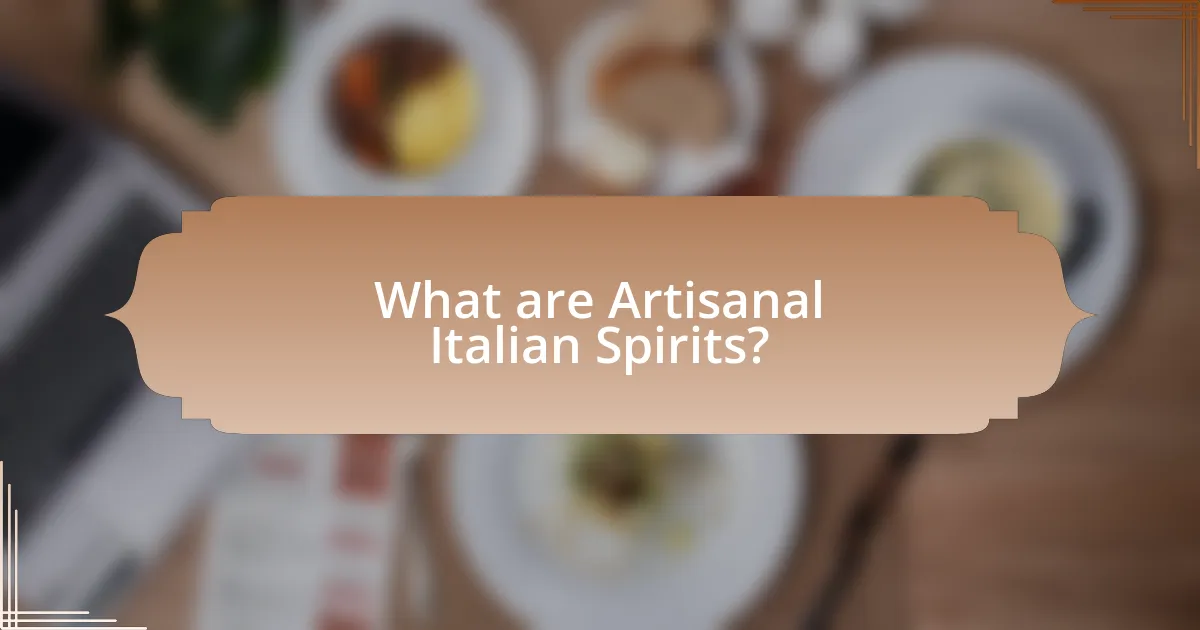
What are Artisanal Italian Spirits?
Artisanal Italian spirits are handcrafted alcoholic beverages produced in small batches, emphasizing traditional methods and high-quality ingredients. These spirits often include products like grappa, amaro, and limoncello, which reflect regional flavors and heritage. The production process typically involves local botanicals, fruits, and grains, ensuring authenticity and unique taste profiles. The revival of these spirits has gained momentum due to a growing consumer interest in craft beverages, with many producers focusing on sustainable practices and preserving local traditions.
How are Artisanal Italian Spirits defined?
Artisanal Italian spirits are defined as high-quality, small-batch alcoholic beverages produced using traditional methods and local ingredients. These spirits often reflect regional characteristics and cultural heritage, emphasizing craftsmanship over mass production. For instance, products like grappa and amaro are typically made by local distillers who adhere to age-old recipes and techniques, ensuring authenticity and unique flavor profiles. The focus on artisanal production methods is supported by the increasing consumer demand for authentic and locally-sourced products, which has led to a resurgence in the popularity of these spirits in both domestic and international markets.
What distinguishes artisanal spirits from mass-produced options?
Artisanal spirits are distinguished from mass-produced options primarily by their production methods, which emphasize small-batch crafting, traditional techniques, and high-quality ingredients. Artisanal producers often prioritize flavor complexity and authenticity, utilizing local botanicals and time-honored recipes, while mass-produced spirits typically rely on industrial processes that prioritize efficiency and uniformity. For example, artisanal distilleries may use pot stills and natural fermentation, resulting in unique flavor profiles, whereas mass production often employs column stills and additives to achieve consistency. This focus on craftsmanship and quality in artisanal spirits is supported by a growing consumer preference for authentic and locally sourced products, reflecting a broader trend towards sustainability and heritage in the beverage industry.
What traditional methods are used in the production of these spirits?
Traditional methods used in the production of artisanal Italian spirits include pot distillation, maceration, and aging in wooden barrels. Pot distillation, a time-honored technique, allows for the preservation of the spirit’s natural flavors and aromas, often resulting in a richer profile. Maceration involves soaking botanicals in alcohol to extract essential oils and flavors, a process crucial for spirits like grappa and amaro. Aging in wooden barrels imparts unique characteristics to the spirits, enhancing their complexity and depth. These methods have historical significance, with pot distillation dating back to the Middle Ages and maceration practices rooted in ancient traditions, ensuring the authenticity and quality of the final products.
Why is there a growing interest in Artisanal Italian Spirits?
There is a growing interest in artisanal Italian spirits due to a rising consumer preference for authenticity and craftsmanship in beverages. This trend is driven by a desire for unique flavors and traditional production methods, which artisanal spirits often embody. According to a report by the IWSR, the premium spirits segment, including artisanal products, has seen significant growth, with consumers increasingly willing to pay more for high-quality, locally sourced options. Additionally, the resurgence of regional Italian distillation techniques and the emphasis on sustainable practices further enhance the appeal of these spirits, aligning with contemporary consumer values.
What cultural factors contribute to the revival of these spirits?
Cultural factors contributing to the revival of artisanal Italian spirits include a growing appreciation for traditional craftsmanship and local ingredients. This resurgence is driven by consumers’ increasing desire for authenticity and unique flavors, leading to a preference for small-batch production methods. Additionally, the rise of food and drink tourism in Italy has highlighted regional spirits, fostering a renewed interest in local heritage and artisanal practices. The emphasis on sustainability and organic farming also plays a significant role, as consumers seek products that reflect environmental consciousness and cultural identity.
How does the trend of local sourcing influence consumer preferences?
The trend of local sourcing significantly influences consumer preferences by increasing demand for products perceived as authentic and sustainable. Consumers are increasingly drawn to locally sourced goods due to a growing awareness of environmental impacts and a desire to support local economies. According to a 2021 survey by the Food Marketing Institute, 67% of consumers prefer to buy local products, indicating a strong preference for items that are produced within their community. This shift not only enhances the perceived quality and freshness of products but also fosters a connection between consumers and producers, reinforcing loyalty to brands that prioritize local sourcing.
What role do regional variations play in Artisanal Italian Spirits?
Regional variations significantly influence the production and characteristics of artisanal Italian spirits. Each region in Italy boasts unique ingredients, traditional distillation methods, and cultural practices that shape the flavor profiles and styles of spirits such as grappa, amaro, and limoncello. For instance, the use of local herbs and fruits, like the lemons from the Amalfi Coast for limoncello, directly impacts the taste and authenticity of the spirit. Additionally, historical practices, such as the use of specific stills or aging techniques, vary by region, further contributing to the diversity of artisanal spirits across Italy. This regional specificity not only enhances the uniqueness of each spirit but also fosters a sense of identity and heritage within local communities, making regional variations a cornerstone of Italy’s artisanal spirit revival.
Which regions in Italy are known for their unique spirits?
The regions in Italy known for their unique spirits include Tuscany, known for its Vin Santo and Grappa; Piedmont, famous for its Vermouth and Grappa; and Campania, recognized for Limoncello. Tuscany’s Vin Santo is a traditional dessert wine, while Piedmont’s Vermouth has a rich history dating back to the 18th century, and Campania’s Limoncello is a popular lemon liqueur that originated along the Amalfi Coast. Each of these regions has distinct local ingredients and traditional production methods that contribute to the uniqueness of their spirits.
How do local ingredients affect the flavor profiles of these spirits?
Local ingredients significantly influence the flavor profiles of artisanal Italian spirits by imparting unique characteristics that reflect the region’s terroir. For example, the use of locally sourced botanicals in gin production can create distinct aromatic notes that are specific to the area, such as the use of juniper berries from the Tuscan hills, which contribute a piney, resinous flavor. Additionally, the incorporation of indigenous fruits, herbs, and spices in spirits like limoncello or amaro enhances their complexity and authenticity, showcasing the local agricultural heritage. This practice not only enriches the sensory experience but also supports local economies and sustainable farming practices, as seen in the revival of traditional distillation methods that prioritize regional ingredients.
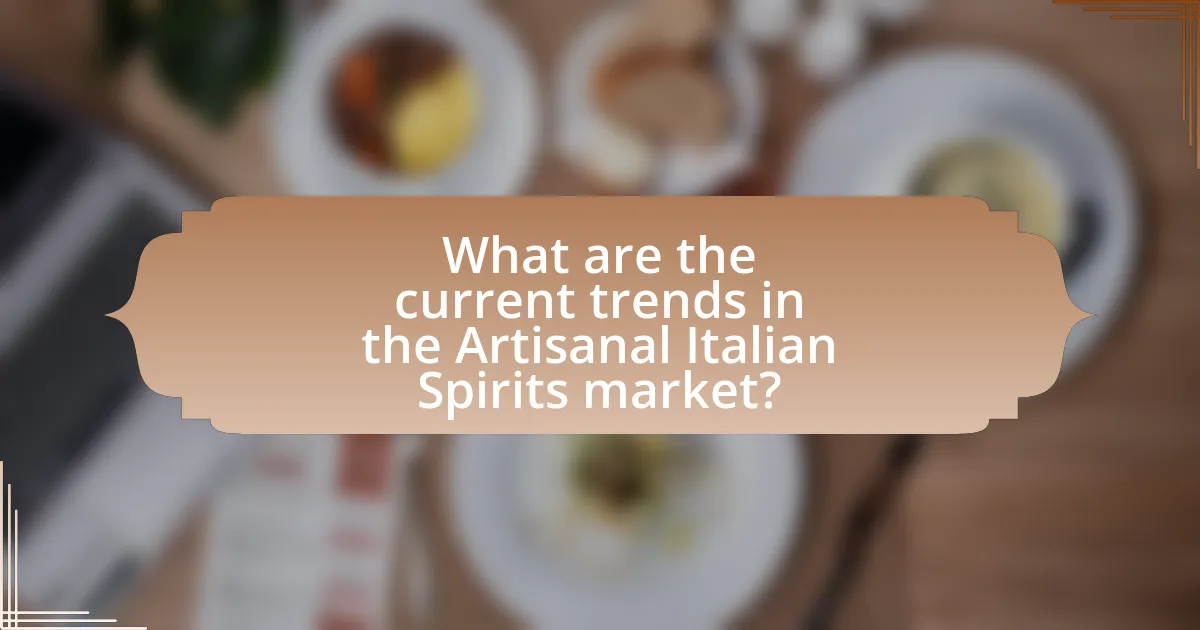
What are the current trends in the Artisanal Italian Spirits market?
The current trends in the Artisanal Italian Spirits market include a growing consumer preference for authenticity, sustainability, and unique flavor profiles. This shift is driven by an increasing demand for locally sourced ingredients and traditional production methods, which enhance the perceived quality and heritage of the spirits. Additionally, the rise of craft cocktails has led to a surge in the popularity of artisanal spirits, with consumers seeking distinctive and high-quality options for their drinks. According to a report by IWSR Drinks Market Analysis, the premium spirits segment, which includes artisanal products, is projected to grow significantly, reflecting the broader trend towards premiumization in the beverage industry.
How are consumer preferences shifting in the spirits industry?
Consumer preferences in the spirits industry are increasingly shifting towards artisanal and craft products, reflecting a desire for authenticity and quality. This trend is evidenced by a growing interest in small-batch distilleries and traditional production methods, particularly in the context of Italian spirits, where consumers are seeking unique flavors and heritage. According to a report by IWSR Drinks Market Analysis, the global market for premium spirits has seen a significant rise, with a 6% increase in volume for craft spirits in recent years, indicating a clear consumer preference for artisanal offerings over mass-produced alternatives.
What impact does sustainability have on consumer choices?
Sustainability significantly influences consumer choices by driving preferences towards environmentally friendly products. Research indicates that 66% of global consumers are willing to pay more for sustainable brands, reflecting a growing trend where consumers prioritize eco-consciousness in their purchasing decisions. This shift is particularly evident in the artisanal spirits market, where brands that emphasize sustainable practices, such as organic ingredients and eco-friendly packaging, attract a loyal customer base. Additionally, a study by Nielsen found that products marketed as sustainable experienced a 20% increase in sales compared to their conventional counterparts, underscoring the impact of sustainability on consumer behavior.
How are health-conscious trends influencing spirit production?
Health-conscious trends are significantly influencing spirit production by driving the demand for lower-alcohol and organic options. Producers are responding to consumer preferences for healthier choices by creating spirits with reduced sugar content, natural ingredients, and fewer artificial additives. For instance, the rise of low-calorie cocktails and the popularity of organic spirits have led brands to innovate their recipes, focusing on quality and sustainability. This shift is supported by market research indicating that 60% of consumers are more likely to purchase products labeled as organic or natural, reflecting a broader trend towards wellness in the beverage industry.
What innovations are emerging in the production of Artisanal Italian Spirits?
Innovations in the production of artisanal Italian spirits include the use of sustainable ingredients, advanced distillation techniques, and the incorporation of local botanicals. Producers are increasingly sourcing organic and locally grown materials to enhance flavor profiles while minimizing environmental impact. For instance, some distilleries are adopting vacuum distillation, which allows for lower temperature processing, preserving delicate flavors and aromas. Additionally, the trend of using indigenous herbs and fruits, such as Sicilian lemons and Alpine botanicals, is gaining traction, reflecting regional terroirs and enhancing authenticity. These innovations not only improve the quality of the spirits but also align with consumer demand for transparency and sustainability in production practices.
How are technology and traditional methods being integrated?
Technology and traditional methods are being integrated in the production of artisanal Italian spirits through the use of advanced distillation techniques and digital monitoring systems. For instance, distilleries are employing precision fermentation technology to enhance flavor profiles while maintaining traditional recipes. Additionally, the implementation of data analytics allows producers to optimize ingredient sourcing and production processes, ensuring consistency and quality. This integration not only preserves the authenticity of traditional methods but also improves efficiency and scalability, as evidenced by the rise of craft distilleries that successfully blend heritage with innovation.
What new flavor combinations are being explored by artisans?
Artisans are exploring innovative flavor combinations such as rosemary and grapefruit, saffron and honey, and chili and chocolate in their creations. These combinations reflect a trend towards unique, locally sourced ingredients that enhance traditional Italian spirits. For instance, the use of rosemary and grapefruit not only adds a refreshing twist but also complements the herbal notes found in many Italian liqueurs. Similarly, saffron and honey introduce a rich, aromatic profile that aligns with Italy’s culinary heritage. The pairing of chili and chocolate offers a bold contrast, appealing to consumers seeking adventurous taste experiences.
What marketing strategies are effective for promoting Artisanal Italian Spirits?
Effective marketing strategies for promoting artisanal Italian spirits include leveraging storytelling, emphasizing authenticity, and utilizing social media engagement. Storytelling connects consumers to the heritage and craftsmanship behind the spirits, enhancing emotional appeal. For instance, brands that share the history of their production methods or the local ingredients used can create a stronger bond with consumers. Emphasizing authenticity, such as highlighting traditional distillation techniques or local sourcing, appeals to the growing consumer demand for genuine products. Additionally, social media platforms like Instagram and Facebook allow brands to showcase visually appealing content, engage with consumers through interactive posts, and collaborate with influencers in the food and beverage space, which can significantly increase brand visibility and consumer interest. These strategies align with current market trends that favor artisanal and locally produced goods, as evidenced by the 2022 report from the Distilled Spirits Council, which noted a 20% increase in consumer interest in craft spirits over the past five years.
How do storytelling and heritage play a role in branding?
Storytelling and heritage are crucial in branding as they create emotional connections and authenticity. Brands that incorporate storytelling can convey their history, values, and unique characteristics, which resonate with consumers seeking genuine experiences. For instance, artisanal Italian spirits often highlight traditional production methods and regional origins, enhancing their appeal. Research indicates that brands with strong narratives can increase customer loyalty by up to 55%, demonstrating the effectiveness of storytelling in fostering brand attachment.
What platforms are most effective for reaching target consumers?
Social media platforms, particularly Instagram and Facebook, are the most effective for reaching target consumers in the artisanal Italian spirits market. These platforms allow brands to showcase visually appealing content, engage with consumers through interactive features, and leverage targeted advertising to reach specific demographics. According to a 2022 report by Statista, 54% of consumers use social media to discover new brands, highlighting the importance of these platforms in consumer engagement and brand awareness.

How can consumers engage with Artisanal Italian Spirits?
Consumers can engage with Artisanal Italian Spirits by participating in tastings, visiting distilleries, and exploring local markets. These activities allow consumers to experience the craftsmanship and unique flavors of these spirits firsthand. For instance, many distilleries offer guided tours that include tastings, providing insights into the production process and the heritage behind each spirit. Additionally, local markets often feature artisanal products, enabling consumers to discover and purchase small-batch spirits directly from producers. Engaging with these spirits through educational events and community gatherings further enhances consumer appreciation and knowledge of the artisanal Italian spirit landscape.
What are the best practices for tasting and enjoying these spirits?
The best practices for tasting and enjoying artisanal Italian spirits include using the appropriate glassware, observing the spirit’s appearance, inhaling its aroma, taking small sips, and savoring the finish. Using a tulip-shaped glass enhances the experience by concentrating the aromas, while observing the color and clarity provides insight into the spirit’s quality. Inhaling the aroma allows for a deeper appreciation of the complex scents, which are often indicative of the ingredients and production methods used. Taking small sips helps to fully engage the palate, allowing the taster to identify various flavor notes. Finally, savoring the finish reveals the lingering flavors and overall quality of the spirit, which is essential in evaluating artisanal products.
How should one pair artisanal spirits with food?
To pair artisanal spirits with food, one should consider the flavor profiles of both the spirit and the dish. Artisanal spirits often have unique characteristics that can enhance or complement specific foods. For example, a herbal gin can pair well with seafood due to its botanical notes, while a rich, aged grappa may complement a cheese platter, enhancing the flavors of the cheese.
Research indicates that pairing spirits with food can elevate the dining experience by creating harmony between the flavors. A study published in the Journal of Culinary Science & Technology highlights that the balance of sweetness, acidity, and bitterness in both food and spirits is crucial for successful pairings. Therefore, understanding the primary flavors in both the artisanal spirit and the food is essential for optimal pairing.
What are the recommended serving methods for different types of spirits?
The recommended serving methods for different types of spirits include neat, on the rocks, and in cocktails. Neat serving is ideal for high-quality spirits like whiskey and rum, allowing the drinker to appreciate the full flavor profile. Serving spirits on the rocks, with ice, is common for those who prefer a chilled drink, as it slightly dilutes the spirit while maintaining its essence. Cocktails, which combine spirits with mixers and other ingredients, are popular for enhancing flavors and creating diverse drinking experiences, particularly with gin and vodka. These methods align with traditional practices and contemporary trends in the revival of artisanal Italian spirits, emphasizing quality and craftsmanship.
What resources are available for learning more about Artisanal Italian Spirits?
Books, online courses, and industry publications are valuable resources for learning about Artisanal Italian Spirits. Notable books include “The Italian Art of Spirits” by Marco Pierini, which provides insights into traditional production methods and regional variations. Online platforms like MasterClass offer courses on Italian mixology, focusing on artisanal spirits. Additionally, industry publications such as “Imbibe Magazine” and “The Spirits Business” frequently feature articles on trends and innovations in the artisanal spirits sector, providing up-to-date information and expert opinions.
Where can consumers find artisanal spirits in their area?
Consumers can find artisanal spirits in their area at local distilleries, specialty liquor stores, and farmers’ markets. Many regions have craft distilleries that produce small-batch spirits, often listed on their websites or social media. Specialty liquor stores frequently carry a selection of artisanal brands, and farmers’ markets may feature local producers selling their products directly to consumers. Additionally, online directories and apps can help locate nearby artisanal spirit retailers, enhancing accessibility for consumers interested in unique, locally made options.
What events or festivals celebrate these spirits and their makers?
Events and festivals that celebrate artisanal Italian spirits and their makers include the “Salone del Gusto” in Turin, which showcases traditional food and drink, and “Vinitaly” in Verona, focusing on wine and spirits. These events highlight the craftsmanship behind spirits like grappa and amaro, featuring tastings, workshops, and discussions with producers. For instance, the Salone del Gusto attracts thousands of visitors and emphasizes the importance of local ingredients and traditional methods, reinforcing the cultural significance of these spirits in Italy.
What tips can enhance the experience of exploring Artisanal Italian Spirits?
To enhance the experience of exploring artisanal Italian spirits, one should focus on tasting in a structured manner, such as starting with lighter spirits and progressing to stronger ones. This method allows the palate to adjust and appreciate the nuances of each spirit. Additionally, pairing spirits with traditional Italian foods can elevate the tasting experience, as certain flavors complement each other, enhancing overall enjoyment. Engaging with knowledgeable producers or attending tastings can provide deeper insights into the craftsmanship and history behind each spirit, enriching the exploration. Lastly, taking notes during tastings can help in remembering preferences and distinguishing characteristics of different spirits, making future selections more informed.
